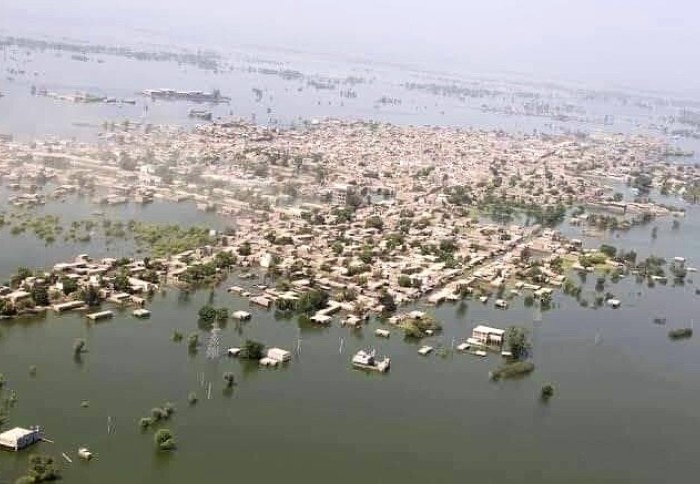
Khairpur Nathan Shah city, Sindh, Pakistan 2022 - c - Ali Hyder Junejo (CC BY 2.0)

Human-caused climate change likely increased the intense rainfall that hit vulnerable populations in Pakistan, finds a new attribution analysis.
Pakistan received more than three times its usual rainfall in August, making it the wettest August since 1961. The rains and resulting flooding killed more than 1,300 people, affected over 33 million more, and destroyed 1.7 million homes.
The two southern provinces, Sindh and Balochistan, experienced their wettest August ever recorded, receiving seven and eight times their usual monthly totals, respectively. The Indus River, which runs the length of the country, burst its banks, flooding thousands of square kilometres of land, while intense local rainfall also led to urban flash floods, landslides and glacial lake outburst floods.
A group of researchers conducted an analysis within a few weeks to uncover the extent to which this extreme weather event, described by United Nations Secretary General António Guterres as a “monsoon on steroids”, was attributable to climate change.
"What we saw in Pakistan is exactly what climate projections have been predicting for years." Dr Friederike Otto
"While it is hard to put a precise figure to the contribution of climate change, the fingerprints of global warming are evident,” said Dr Friederike (Fredi) Otto, Senior Lecturer in Climate Science at the Grantham Institute - Climate Change and the Environment at Imperial College London and co-founder of the World Weather Attribution (WWA) group of scientists.
“What we saw in Pakistan is exactly what climate projections have been predicting for years. It’s also in line with historical records showing that heavy rainfall has dramatically increased in the region since humans started emitting large amounts of greenhouse gases into the atmosphere. And our own analysis also shows clearly that further warming will make these heavy rainfall episodes even more intense,” she said.
Quantifying the impact of climate change
To quantify the effect of climate change on the heavy rainfall, scientists analysed weather data and computer simulations to compare the climate as it is today, after about 1.2°C of global warming since the late 1800s, with the climate of the past, following peer-reviewed methods.
The study was conducted by 26 researchers as part of the WWA group, including leading scientists from universities and meteorological agencies in Denmark, France, Germany, India, the Netherlands, New Zealand, Pakistan, South Africa, the United Kingdom and the United States.
“Our evidence suggests that climate change played an important role in the event, although our analysis doesn’t allow us to quantify how big the role was,” said Dr Otto.
“This is because it is a region with very different weather from one year to another, which makes it hard to see long-term changes in observed data and climate models. This means the mathematical uncertainty is large.”

Attribution: Navigating uncertainties
The researchers focused on two aspects of the event: the 60-day period of heaviest rainfall over the Indus River basin between June and September, and the 5-day period of heaviest rainfall in the Sindh and Balochistan provinces.
They found that modern climate models are not fully able to simulate monsoon rainfall in the Indus River basin, as its rainfall pattern is extremely variable from year to year. Consequently, for the 60-day period of rainfall, they could not quantify the influence of climate change as accurately as has been possible in other WWA studies of extreme weather events.
For the 5-day total rainfall, some models suggest that climate change increased the 5-day total rainfall in Sindh and Balochistan by up to 50%. This is in-line with recent assessments by the Intergovernmental Panel on Climate Change (IPCC) that project more intense rains in the region, and with historical weather records that show these heavy rainfall episodes have increased 75% in the region in the last few decades.
The analysis also suggests that heavy rainfall like that experienced in Pakistan this year now has approximately a 1% chance of happening each year - which is about two to three times more likely than in a climate without human-caused warming.
An exposed and vulnerable population
While the extreme nature of the rainfall and subsequent floods means that some level of impact on local people was likely to be unavoidable, the study highlighted that many factors contributed to increase the damage, including high rates of poverty and political instability in the country.
“The fingerprints of climate change in exacerbating the heatwave earlier this year, and now the flooding, provide conclusive evidence of Pakistan’s vulnerability to such extremes,” said Dr Fahad Saeed, Researcher at the Center for Change and Sustainable Development in Pakistan and a co-author of the new analysis.
“Being the chair of G77 [a United Nations coalition of 134 developing countries], the country must use this evidence in COP27 [the upcoming UN climate change conference in November] to push the world to reduce emissions immediately. Pakistan must also ask developed countries to take responsibility and provide adaptation plus loss and damage support to the countries and populations bearing the brunt of climate change,” he said.
Download the full study: Climate change likely increased extreme monsoon rainfall, flooding highly vulnerable communities in Pakistan (34 pages, 2.8 MB)
To keep up to date with research activities at the Grantham Institute, receive invites to our events and find out about our latest publications, sign up to the Grantham Institute weekly update.
Image: Khairpur Nathan Shah city, Sindh, Pakistan 2022 (c) Ali Hyder Junejo (CC BY 2.0)
Supporters

Article text (excluding photos or graphics) © Imperial College London.
Photos and graphics subject to third party copyright used with permission or © Imperial College London.
Reporters
Lottie Butler
The Grantham Institute for Climate Change
Simon Levey
Communications Division

Contact details
Email: s.levey@imperial.ac.uk
Show all stories by this author



